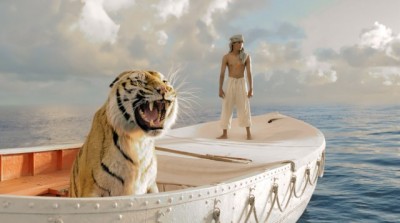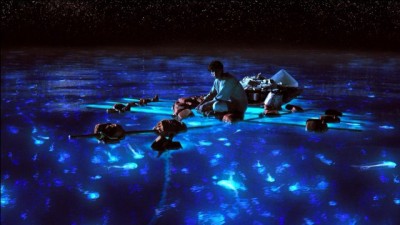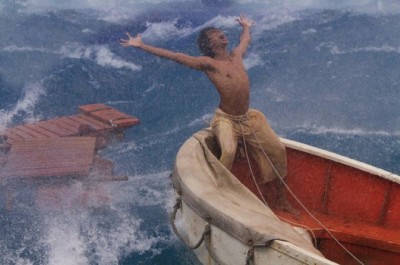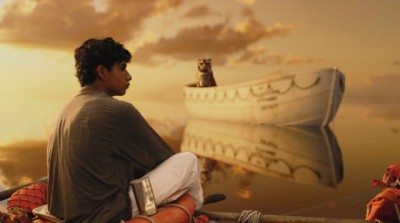
Ang Lee’s Life of Pi is a film both wonderful and frustrating — and about in equal measure. Without having read Yann Martel’s source novel, I suspect that it is the source of the latter. It may also be a question of how pre-sold you are on the story’s overall mystical bent and the idea that the tale being told “will make you believe in God.” And that perhaps indicates a personal failing in me because while Lee’s full-on “wow” images evoked the kind of wonderment that might lead to that kind of cosmic fulfillment, the story itself never did. The strange thing about that is I’m usually a sucker for religious allegory — at least while it’s on the screen — and Life of Pi just didn’t move me. I think it’s too literal, too matter of fact — and I think, most of all, it tries too hard to verbalize a message that rightly belongs to the visuals. There’s something more concerning the film’s “twist,” but that gets into the realm of “spoilers,” so I’ll leave that for later where you can choose to read or not.

By now, you probably know that the film is the story of a man, Pi Patel (Irrfan Khan), telling the story of his earlier life to a writer (Rafe Spall). This story — the one that “will make you believe in God” — forms the bulk of the film. First, he sketches in his early years of living with his parents in their picture book zoo in India. It is here that we learn of the young man’s rather simplistic ability to assimilate a variety of religions — Hinduism, Christianity, Islam and, apparently, a touch of the Kabbalah — into a conflict-free melange of faith, none of which sits all that well with his rationalist father (Adil Hussain). Here, too, we meet the zoo’s Bengal tiger with the improbable name of Richard Parker. It’s this tiger that teenage Pi (Suraj Sharma) ends up sharing a lifeboat with — along (briefly) with a stranded orangutan, a seriously injured zebra and a singularly nasty hyena — for 227 days following a shipwreck. This, of course, is the film’s centerpiece — and however you end up feeling about the story itself, the visual splendor of it all is undeniable.

We’ve gotten a hint of this in the early scenes with their complex overlaid images and transitions. Plus, the shipwreck that lands them in their predicament is wonderfully staged. But none of this really prepares us for the amazing — and hard to effectively describe — images of the sea, the boat on the sea, the relation of the living creatures to their surroundings etc. Actually, it is this that impressed me far more than the completely believable, but mostly CGI animals — and those can only be described as amazing in themselves. It’s the film’s sense of endless space, its almost hallucinatory fusion of sky and sea and its unbearably beautiful and at the same time terrifying images that that sell the film. (And these images are where the film is much nearer the idea of God than in any of the story itself.)

Lee films everything in a kind of classical Hollywood manner so that shots tend to be held long enough for us — as well as Pi and perhaps even the tiger — to marvel at them and take them in. It’s this seemingly unfussy filmmaking that makes it possible to stop bothering about whether any of this is believable. And then we hit the last 15 minutes or so. Here is where you might want to stop reading if you haven’t seen the film and don’t know the story. Suddenly, the film hits us with a twist where Pi offers us an alternate —and much more prosaic — version of what happened and leaves the choice of which story the writer (and we) prefer. Well, taking a tip from John Ford’s The Man Who Shot Liberty Valance and its “When the legend becomes fact, print the legend,” it’s no contest. And while, yes, it easily makes me believe that the legend is more compelling and satisfying, it only strengthens my belief in the power of storytelling, not God. But I suspect that is grounded in what I brought to the film. What you bring to the film may produce a different result. Rated PG for emotional thematic content throughout, and some scary action sequences and peril.
Playing at Carmike 10




Well I was beyond satisfied in terms of visuals and sheer “movie-magic”. And this was fun enough to where my girlfriend and I were calling her cat Richard Parker for a couple of days. But Hugo it ain’t.
I wonder which film-maker will have me rushing out for my 2013 3D experience. I’d say Danny Boyle would make a good candidate.
I’m saying Baz Luhrmann, but then we know he’s got one coming out early summer.
Oh, that’s right! I’d forgotten that Luhrmann decided to adapt the pop-up version of The Great Gatsby. Should be fun.
It should certainly be the most visually interesting version of the story.